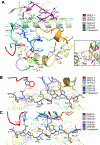A high-affinity human TCR-like antibody detects celiac disease gluten peptide-MHC complexes and inhibits T cell activation
- PMID: 34417258
- PMCID: PMC8670751
- DOI: 10.1126/sciimmunol.abg4925
A high-affinity human TCR-like antibody detects celiac disease gluten peptide-MHC complexes and inhibits T cell activation
Abstract
Antibodies specific for peptides bound to human leukocyte antigen (HLA) molecules are valuable tools for studies of antigen presentation and may have therapeutic potential. Here, we generated human T cell receptor (TCR)-like antibodies toward the immunodominant signature gluten epitope DQ2.5-glia-α2 in celiac disease (CeD). Phage display selection combined with secondary targeted engineering was used to obtain highly specific antibodies with picomolar affinity. The crystal structure of a Fab fragment of the lead antibody 3.C11 in complex with HLA-DQ2.5:DQ2.5-glia-α2 revealed a binding geometry and interaction mode highly similar to prototypic TCRs specific for the same complex. Assessment of CeD biopsy material confirmed disease specificity and reinforced the notion that abundant plasma cells present antigen in the inflamed CeD gut. Furthermore, 3.C11 specifically inhibited activation and proliferation of gluten-specific CD4+ T cells in vitro and in HLA-DQ2.5 humanized mice, suggesting a potential for targeted intervention without compromising systemic immunity.
Copyright © 2021 The Authors, some rights reserved; exclusive licensee American Association for the Advancement of Science. No claim to original U.S. Government Works.
Figures








References
-
- Krogsgaard M, Wucherpfennig KW, Cannella B, Hansen BE, a Svejgaard, Pyrdol J, Ditzel H, Raine C, Engberg J, Fugger L, Visualization of myelin basic protein (MBP) T cell epitopes in multiple sclerosis lesions using a monoclonal antibody specific for the human histocompatibility leukocyte antigen (HLA)-DR2-MBP 85–99 complex., J. Exp. Med. 191, 1395–1412 (2000). - PMC - PubMed
-
- Weidanz JA, Piazza P, Hickman-Miller H, Woodburn D, Nguyen T, Wahl A, Neethling F, Chiriva-Internati M, Rinaldo CR, Hildebrand WH, Development and implementation of a direct detection, quantitation and validation system for class I MHC self-peptide epitopes, J. Immunol. Methods 318, 47–58 (2007). - PubMed
-
- Dahan R, a Gebe J, Preisinger A, a James E, Tendler M, Nepom GT, Reiter Y, Antigen-specific immunomodulation for type 1 diabetes by novel recombinant antibodies directed against diabetes-associates auto-reactive T cell epitope., J. Autoimmun. 47, 83–93 (2013). - PubMed
Publication types
MeSH terms
Substances
Grants and funding
LinkOut - more resources
Full Text Sources
Other Literature Sources
Medical
Molecular Biology Databases
Research Materials

